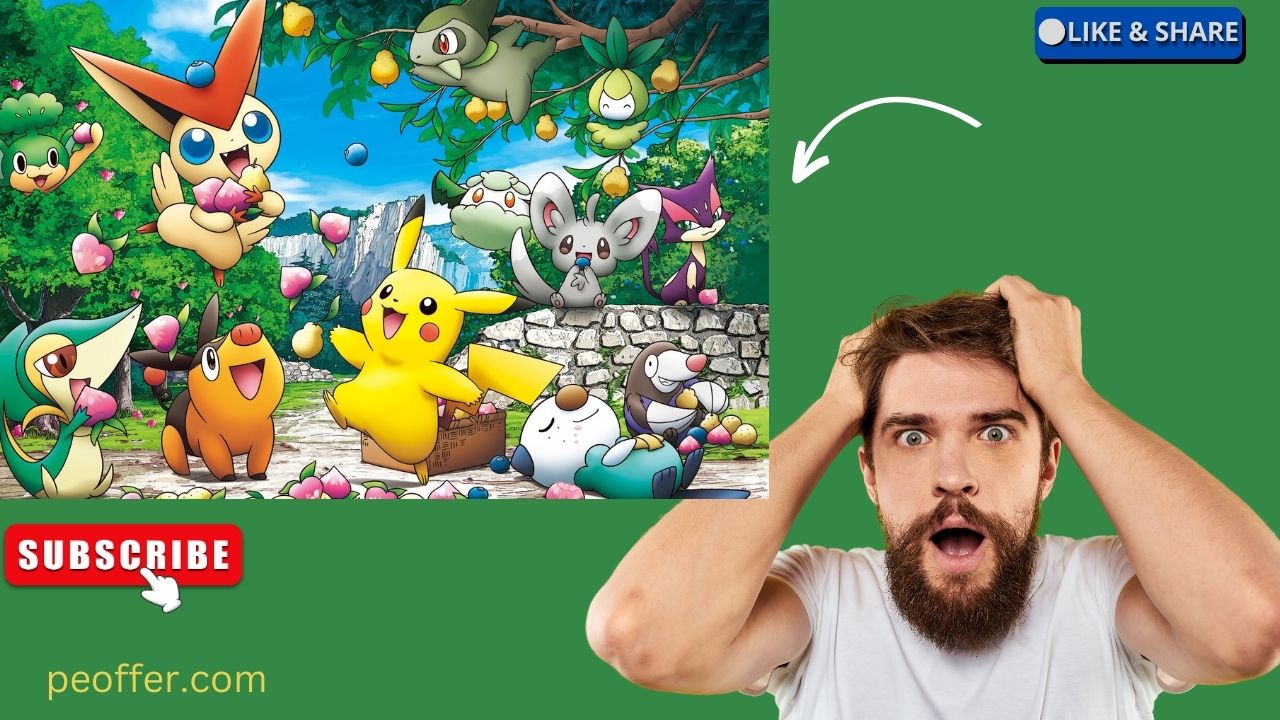
The Complete Guide to Pokémon: History, Games, Cards, and More
Pokémon, short for “Pocket Monsters,” is one of the most successful and beloved franchises in the world, capturing the hearts of fans of all ages for nearly three decades. From its start as a pair of video games in Japan to a multimedia empire spanning games, TV series, trading cards, movies, merchandise, and more, Pokémon has become a global cultural phenomenon.
In this comprehensive guide, we’ll explore the history, impact, and various aspects of the Pokémon franchise, including popular games, trading card collecting, and tips for fans old and new.

1. The Origins of Pokémon: A Look Back
The Pokémon franchise was created by Satoshi Tajiri and Ken Sugimori, and it launched in 1996 in Japan with two video games: Pokémon Red and Pokémon Green (which later became Red and Blue internationally). Tajiri, inspired by his childhood love of collecting creatures, wanted to create a game where players could collect and trade monsters.
The idea of “catching them all” became central to Pokémon’s appeal. Players, known as Pokémon Trainers, would travel a fictional world to capture Pokémon, train them, and battle against other Trainers. This gameplay concept, paired with the strategic depth of training and battling, made Pokémon instantly popular.
2. The Evolution of Pokémon Games
The Pokémon games have expanded significantly over the years. Here’s a quick overview of each main generation and its key features:
Generation 1: Red, Blue, and Yellow (1996-1999)
- Region: Kanto
- Notable Pokémon: Pikachu, Bulbasaur, Charmander, Squirtle
- Significance: Established the iconic 151 Pokémon, and Pokémon Yellow featured Pikachu as a primary companion.
Generation 2: Gold, Silver, and Crystal (1999-2002)
- Region: Johto
- Notable Pokémon: Togepi, Lugia, Ho-Oh
- Significance: Introduced breeding, day-night cycles, and 100 new Pokémon.
Generation 3: Ruby, Sapphire, and Emerald (2002-2006)
- Region: Hoenn
- Notable Pokémon: Kyogre, Groudon, Rayquaza
- Significance: Added weather effects and double battles.
Generation 4: Diamond, Pearl, and Platinum (2006-2010)
- Region: Sinnoh
- Notable Pokémon: Dialga, Palkia, Giratina
- Significance: Introduced online trading and battling, allowing global connectivity.
Generation 5: Black, White, Black 2, White 2 (2010-2013)
- Region: Unova
- Notable Pokémon: Zekrom, Reshiram
- Significance: Brought in seasons, animated sprites, and 3D cutscenes.
Generation 6: X and Y (2013-2016)
- Region: Kalos
- Notable Pokémon: Xerneas, Yveltal
- Significance: Introduced Mega Evolutions and a shift to full 3D graphics.
Generation 7: Sun, Moon, Ultra Sun, Ultra Moon (2016-2019)
- Region: Alola
- Notable Pokémon: Solgaleo, Lunala
- Significance: Removed traditional Gym battles and introduced the “Z-Move” mechanic.
Generation 8: Sword and Shield (2019-Present)
- Region: Galar
- Notable Pokémon: Zacian, Zamazenta
- Significance: Introduced the “Dynamax” and “Gigantamax” mechanics, as well as the first fully open-world areas.
3. Pokémon Trading Card Game (TCG)
Alongside the video games, the Pokémon Trading Card Game (TCG) has become a cultural staple and highly popular collectible card game. Released in 1996 in Japan and 1999 internationally, it has remained one of the most successful card games, rivaled only by games like Magic: The Gathering.
Key Elements of Pokémon TCG
- Types of Cards: There are three main types: Pokémon cards (featuring creatures), Energy cards (needed to use attacks), and Trainer cards (providing various in-game effects).
- Rarities: Pokémon cards come in various rarities, including Common, Uncommon, Rare, and special Ultra Rare or Secret Rare cards that are highly sought after by collectors.
- Competitive Play: Players build a deck and face off against each other in battles, aiming to knock out the opponent’s Pokémon by depleting their HP. Winning tournaments can earn serious prizes, making the game competitive and strategic.
The Rise of Pokémon Card Collecting
In recent years, Pokémon card collecting has experienced a surge in popularity. Vintage cards, particularly 1st Edition Charizard from the original base set, can sell for thousands of dollars. Special edition and holographic cards, along with limited releases, continue to fuel the collectible market.
4. Pokémon Anime: The Story of Ash and Pikachu
The Pokémon anime series began in 1997 and follows the journey of Ash Ketchum and his companion, Pikachu, as they explore different regions, meet new Pokémon, and aim to become the Pokémon Master. Known for its light-hearted humor, life lessons, and iconic moments, the anime has reached multiple generations.
Key Features of the Pokémon Anime
- Ash’s Journey: Ash’s story centers on friendship, perseverance, and growing stronger with his Pokémon. Each season takes place in a new region, inspired by the mainline games.
- Memorable Episodes: With over a thousand episodes, the anime has featured emotional moments (like Ash saying goodbye to Butterfree) and thrilling battles.
- Movies: Pokémon has released over 20 movies that add depth to the lore and often introduce Legendary or Mythical Pokémon.
5. Pokémon GO: The Mobile Phenomenon
In 2016, Pokémon GO, a mobile game developed by Niantic, brought Pokémon to the real world using augmented reality (AR). It quickly became a global sensation, allowing players to “catch” Pokémon in real-world locations by exploring parks, cities, and landmarks.
Pokémon GO Features
- Real-World Exploration: Pokémon GO encourages walking and exploring outdoor areas. Pokémon appear in locations based on geography and environment, enhancing the immersive experience.
- Gyms and Raids: Players can battle and capture powerful Pokémon through Raid Battles at gyms, where Trainers work together to defeat legendary Pokémon.
- Community Events: Pokémon GO frequently hosts events, such as Community Days, where rare Pokémon spawn more frequently, often with unique moves and special bonuses.
6. Pokémon Merchandise and Culture
Pokémon’s reach extends far beyond games and cards, encompassing a massive array of merchandise and a vibrant fan culture. From clothing, plush toys, and stationery to specialized items like the Pokédex toy or Poké Ball Plus controller, there is something for every type of Pokémon fan.
Pokémon Centers
Pokémon Centers are official retail stores that offer exclusive Pokémon-themed merchandise. These stores can be found in Japan, the United States, and online, selling limited-edition items, clothing, plushies, and other exclusive Pokémon products.
Fan Events and Conventions
Fans often gather at events like Pokémon World Championships, where players compete in video game and TCG tournaments. Pokémon-themed events and conventions allow fans to meet other Trainers, trade cards, and celebrate their shared love for the franchise.
7. Tips for New Pokémon Trainers
If you’re new to Pokémon or looking to improve your game, here are some helpful tips:
1. Choose Your Starter Wisely
In most Pokémon games, your starter Pokémon (usually a choice between Grass, Fire, and Water types) can affect your early battles. Consider the type advantages of each choice to plan ahead.
2. Learn About Types and Weaknesses
Understanding type matchups is crucial in Pokémon battles. For instance, Water-type moves are super effective against Fire-types but weak against Grass-types. Mastering type advantages gives you an edge.
3. Build a Balanced Team
Create a team with diverse types to handle different opponents. A balanced team includes various types that cover each other’s weaknesses, making you more adaptable in battles.
4. Experiment with Moves
Each Pokémon can learn a variety of moves. Experiment with different attacks to find the best strategies and combinations. Moves can be physical, special, or status-based, each serving different tactical purposes.
8. How Pokémon Has Shaped Pop Culture
From TV shows and merchandise to memes and popular sayings like “Gotta Catch ‘Em All,” Pokémon has had an indelible impact on pop culture. Pikachu, in particular, has become an international icon, recognized as one of the most famous video game mascots alongside Mario and Sonic.
The franchise’s blend of adventure, discovery, and nostalgia has made it appealing across generations, and its reach has grown with the internet, where communities, discussions, and fan art celebrate everything Pokémon.
9. Looking to the Future: What’s Next for Pokémon?
The Pokémon Company continues to release new games, cards, shows, and movies, evolving with technology and player interests. Recently, titles like Pokémon Legends: Arceus brought open-world mechanics to the Pokémon series, while







